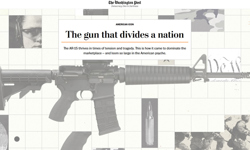As print and online publishing models battle for share of readership, alongside both there sits a third, often neglected channel – mobile. Publishers have nervously eyed mobile phones for a number of years now. They have the advantage of being portable, personal devices that can be accessed on the move, just like a newspaper or magazine. Unfortunately, delivering content on a par with the internet, at a price users will accept, has proved difficult. Recent changes in the mobile market and growing awareness among publishers mean this could be about to change.
Going off-portal
Neither newspaper nor magazine publishers have shown undue haste in embracing the mobile channel, but some are ahead of the game. On the magazine front, Dennis Publishing was quick to spot the potential for distributing content from titles that coincided with the taste of young mobile users, such as from flagship ladmag Maxim. The company had been distributing its content via the mobile networks’ portals for a number of years. In November 2007, it launched its off-portal site, Maxim Mobile, hosting a range of content drawn from the title.
The Sun leads the red tops with its commitment to mobile. The paper has been offering standard fare such as ring tone downloads for a number of years, but has significantly increased its mobile presence since the appointment in 2006 of Andrew Bagguley, former head of international portal management at T-Mobile, as head of mobile strategy for News Group Newspapers. "My brief was to roll out mobile internet sites which allowed open access to content, and acquire rights for mobile content," says Bagguley. In the summer of 2007, the paper’s mobile internet site – thesun.mobi – was rolled out. August 2007 also saw the launch of 24-7 Football a joint venture with Sky allowing access to premier matches via a mobile phone.
Both publishers have faced challenges in persuading their readers that mobile is a viable means to access their favourite publications: "Mobile phones don’t match up with the user’s expectations of them," says Dennis Publishing’s head of mobile Andrew Nicholls. "They’re not just for texting and speech, they are multimedia devices."
The concept of the mobile internet providing a credible online experience is also one many users still wrestle with says Bagguley: "People find it hard to conceptualise mobile sites. They ‘get’ online and have expectations of what a website will deliver, but they don’t know what to expect from a mobile site."
It costs how much?
A bigger concern for all publishers has been the costs of accessing mobile content, that the networks have been levying. "The costs have been high and ‘billshock’ has been a big factor in holding people back," says Nicholls. "In addition to paying for individual downloads, users have also been charged by the networks for the data used in accessing mobile sites."
This cost consideration became less of a concern last year when the networks finally relaxed their stances on charging for data: "There are three things that have helped the market to pick up recently," says Paul Cox, chief technical officer at mobile solutions firm Roundpoint, which counts the Independent, Telegraph and Economist among its clients. "Firstly, mobiles now have much better technology to host and display content. Secondly, the launch of the iPhone with the support of Apple’s marketing clout has drawn people’s attention to the mobile internet. And finally, most importantly, the networks have at last introduced flat-rate data plans."
Flat-rate plans mean that for a monthly fee, mobile users can browse mobile internet sites without fear of incurring the huge bills for data use that the old ‘pay as you go’ arrangement saddled them with. The appearance on the scene of these deals is crucial to the future of mobile publishing says Nicholls: "This has made access to content ‘free’ to those signing up for these deals. People have wanted something closer to the open model of the internet where they don’t have to pay for access and now they have it."
Not that publishers have abandoned network portals completely as valid means to distribute their content to users: "We fish where the fish are, and that means including the network portals as this is what many people are familiar with," says Bagguley. "With something like the 24-7 football product, the cost of accessing this on the open site is expensive without a fixed rate data plan which only around 20% of users currently have. But if it’s downloaded via a portal, although the customer will pay for the service, the mobile data costs are effectively ‘given away’ by the network."
Types of content
The choice of content offered to the mobile user varies widely. Some publishers choose to offer the entire content of their publications, usually to subscribers: "For some people, the mobile is a fallback device for accessing the internet when they can’t get to their PC," says Cox. The majority of titles provide more digestible chunks: "It’s short sharp stuff like video clips that people can take in while they are waiting at the bus stop," says Nicholls.
Mobile distribution of the Sun’s content outstrips many of its more high-brow rivals in terms of reach. The 24-7 football product is available across all five mobile networks with further content filtering out via portals and the open access thesun.mobi website. A selection of the top news stories of the day are posted to mobile, optimised for reproduction in this medium: "It’s the same news product, undiluted, even if the networks don’t like what we’re saying," says Bagguley. Readers can also sign up for news text alerts and subscribe to news exclusives from News of the World which are released to mobile at 10pm on Saturday night.
Revenue models
With off-portal access to content now a realistic option, publishers are beginning to review their revenue models. Traditionally, revenue generation from mobile content has been driven by subscriptions, but this could be changing as advertisers reassess the medium: "In the past, the advertising we received often came from mobile companies offering mobile services. Now we have major advertisers selling big brands. They are beginning to regard mobile in the same light as the internet or TV," says Nicholls.
Not everyone, however, is convinced that advertising is offering adequate returns: "The problem with advertising is that there isn’t enough money in it at the moment," says Bagguley. The Sun still relies on revenue from distribution of content via portals and a mixture of subscriptions and paid-for downloads from its well established content offers: "Page three remains a popular download, as do monthly and weekly horoscopes, although daily horoscopes would be free," says Bagguley.
Bagguley believes that the advertising industry still needs convincing of the merits of mobile: "There is a big job to be done selling the media to the agencies. We have had some advertising campaigns brought directly to us by brands, but a lot of the high value campaigns still go online because media agencies question mobile’s effectiveness, despite there being two to three million people browsing mobile internet sites everyday."
Metrics needed
One thing that may bring the advertising community around is the introduction of reliable metrics to measure the mobile audience. The absence of an agreed metric is something the industry is currently seeking to remedy. The mobile industry body, the GSMA, recently announced its intention to introduce a standard metric. However, this may not be a straightforward process. "As publishers, we can offer advertisers figures on page impressions and visitor numbers, but we can’t give a figure for unique users; only the networks themselves can do this," says Bagguley. "They own the customer's mobile number and therefore can tell you age, gender, location etc. We have to opt people in and that's not easy on mobile. Network portals capture the mobile phone number when people are browsing. We don't get this information and the networks don't pass this on because of data protection. So we just see a hit or visit and it’s harder to know who the customer is."
Whilst the jury may still be out on the speed with which advertisers will embrace the medium, sponsorship is already beginning to play a role. To coincide with the launch of the football season in August 2007, BT Vision sponsored the Sun’s Dream Team fantasy football game across paper, online and mobile.
The paper now actively promotes this three tier - paper, online, mobile – approach on its masthead. Bagguley claims this is for the benefit of readers and advertisers alike: "We want to make advertisers aware of our cross platform approach, but we are also in the process of educating our readership."
Contrary to popular belief, the Sun’s readership is drawn from a broad demographic though Bagguley admits that part of the reason for the paper’s investment in mobile is the preponderance of mobile phone use among its readers: "Around 91% of our readership has a mobile phone, so there is a significant overlap and it’s a young emerging market. Aggregated readership for the Sun, across all media, grew from 20m to 22m from 06 to 07 and a lot of this increase is coming from online and mobile."
Looking forward, advances in technology and mobile content models will of course influence the decisions publishers take: "Big changes will come in the areas of mobile search and mobile TV," says Nicholls. "TV still faces some challenges, but as we move from the portal model to an open model like the internet, search engines and search engine optimisation become important. We need to ensure that when someone taps the phrase ‘girls’ into their handset, Maxim comes top of the list not FHM."
In the meantime, many publishers are waking up to the possibilities and challenges this still-emerging media presents: "Our competitors are now hiring people to do what I do, but the challenge is how quickly the mobile channel can be adopted into the editorial function," says Bagguley.
FEATURE
Mobile: opening up
Some of the inflexibilities, and high charges, that used to characterise mobile are beginning to fall away and publishers are renewing their efforts to capitalise on the unquestioned strengths of the sector. Patrick Dye talks to two early adopting publishers.










